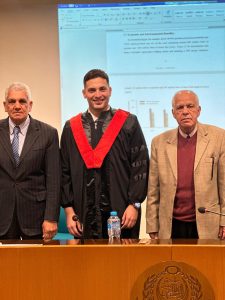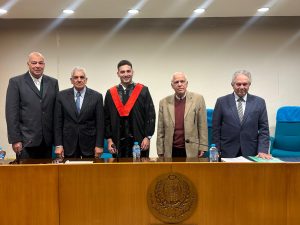Modeling, simulation, and experiments on waste kinetic energy utilization
Masters of science (MSc) 2023
By
Mohamed Hazem Ali Abdelhamid Mansour
Supervisors
Prof. Kamal A. Ibrahim
Mechanical Engineering Department
Faculty of Engineering
Monofia University
Prof. ElSayed Saber
Mechanical Engineering Department
College of Engineering and Technology
Arab Academy for Science and Technology and Maritime Transport
Mechanical Engineering Department
College of Engineering and Technology
Arab Academy for Science and Technology and Maritime Transport
Abstract
Saving energy is important as energy production. In systems like cars, trains, elevators, and machines that require frequent start/stop operation, a significant amount of kinetic energy is wasted during braking. It may be necessary to employ a sophisticated braking mechanism to catch waste kinetic energy for later usage. Several criteria influence the proposed braking mechanism. A hydraulic test bench is developed and built to investigate how much kinetic energy can be absorbed and stored during braking using a hydraulic circuit. The test bench’s driving power is a variable voltage and variable frequency electric motor that drives a flywheel that constitutes the majority of the kinetic energy with speeds ranging from 876 to 2975 rpm. A positive displacement gear pump, flow control valve, non-return valve, on/off valve, direction control valve, and an accumulator are the major components of the hydraulic circuit. The use of an automated contactor and a magnetic clutch allows for alternate operations between the mechanical system and the hydraulic brake circuit. The entire system is theoretically modeled, and a MATLAB code is created to investigate the impact of various parameters on the braking mechanism’s performance. Four groups of experiments were conducted to investigate the features of the driving and braking systems, as well as the influence of various factors on the amount of energy that may be collected during braking. The results indicate that 18% to 55% of the kinetic energy may be absorbed and transformed into hydraulic power stored in the accumulator. The amount of hydraulic power gained is governed by the operating speed and restriction ratio (hydraulic system resistance). At certain rotational speeds and restriction ratios, maximum gain of hydraulic power could well be produced. Not only can braking energy regeneration improve system efficiency, but it also provides environmental benefits. Alexandria, Egypt is used as a case study to investigate the economic and environmental benefits of employing this technology in cars.
Published Papers
R. Afify, M. Mansour, E. Saber, K.A. Ibrahim, “Modeling, simulation, and experiments on waste kinetic energy utilization“, Energy Reports, vol. 8, pp. 231-249, 2022. https://doi.org/10.1016/j.egyr.2022.06.106
Afify, R.S., Mansour, M., Saber, E., Ibrahim, K. A., “Modeling, simulation, and experiments on waste kinetic energy utilization”, Technologies and Materials for Renewable Energy, Environment and Sustainability, TMREES21Gr Int’l Conf. Paris – France, 9-11 May 2022. Certificate



